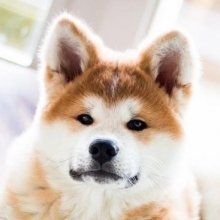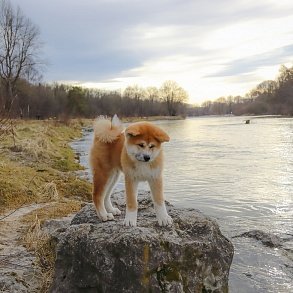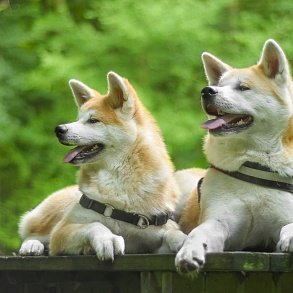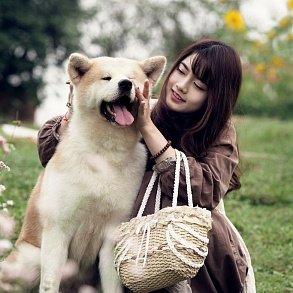Akita inu

Akita Inu is one of the oldest dog breeds on Earth, bred in the northern regions of Japan. This is a proud, strong and loyal pet.
- Brief information
- Highlights
- Breed characteristics
- History of the Akita Inu breed
- Features of the American Akita
- Appearance and special features of the breed
- Life expectancy
- Akita-inu character
- Training and education
- Care and maintenance
- Features of care
- Health and diseases of akita inu
- How to choose a puppy
- How much does an akita inu cost
Brief information
- Breed Name: Akita inu
- Country of Origin: Japan
- The time of the birth of the breed: 1964
- Weight: 23 – 39 kg
- Height (height at the withers): males 64 – 70 cm, females 58 – 64 cm
- Lifespan: 10-12 years
Highlights
- Akita Inu doesn't like other dogs, especially her own sex.
- Proper upbringing, long-term socialization, competent training are extremely important, otherwise the animal can grow aggressive.
- They are noble and restrained, but only when they recognize the owner as an unconditional leader.
- Akita sheds profusely twice a year.
- Dogs feel good in the house and apartment, but require frequent walks, physical exertion.
Akita inu - spitz-like dogs bred in the north of Japan (Akita Prefecture). They have a muscular build and thick short hair. The temper is dominant, independent, requiring persistent training and respectful attitude. This breed is suitable for experienced dog breeders, calm, confident people. There are two lines, occasionally classified as different breeds: akita-inu ("authentic" subspecies) and American akita .
Breed characteristics
History of the Akita Inu breed
According to information from ancient historical sources in Japan, the ancestor of modern representatives of the breed is matagi-inu (matagi is an ethnic group of hunters, Inu is a "dog"). The Akita Inu's region of origin is considered to be Akita Prefecture on Honshu Island. Matagi-inu and her ancestors served people as irreplaceable assistants in hunting, allowing them to get even very large or agile animals: Japanese macaques, bears, wild boars.
In the XII-XIII centuries, a new popular entertainment appeared in Japan – dog fighting. It has become a cruel selection for these dogs, leaving only the strongest, angriest and hardiest. In the XIX century, a wave of industrialization swept through the country, many residents moved, the number of crimes increased. Because of this, the matagi Inu were retrained to guard property. At the same time, bullmastiffs and mastiffs, Great Danes were brought from Europe to Japan, reviving the tradition of dog fighting. Increasingly, the Akita was crossed with these dogs to get more aggressive and larger dogs.
This caused concern among Japanese dog breeders, because the breed began to lose its features, so in 1931 the Akita Inu were transferred to the status of a natural monument at the state level. Breeders actively engaged in the revival of the breed, selecting only the best of its representatives for breeding. In 1934, the first official standard was introduced, but over time it had to be adjusted. Around the same time, the breed got its modern name, and in 1967 a thematic museum was opened.
The Akita Inu suffered serious damage during World War II - these dogs almost disappeared. They suffered from hunger, became victims of barely surviving people, their skins were used for clothing. At the end of the war, a state decree was issued on the extermination of all dogs unsuitable for military use, since a real epidemic of rabies began in Japan. For this reason, breeders hid some representatives of the breed in remote settlements, breeding them with matagi-inu. Also, amateurs bred hybrid generations of Akita with German Shepherd to adapt them for military service.
After the war, a new round of restoration of the Akita Inu breed began, the greatest contribution to which was made by Morie Savataishi - it was thanks to him that these unique dogs have survived to this day. Purebred individuals had to be collected all over the country, but it bore fruit. The American military liked the charming and proud Akita, so the breed was brought to the USA.
Video: Akita inu
Features of the American Akita
The American branch of this breed appeared exactly after the Second World War, when the US military began to export puppies to their homeland. Interestingly, they were mainly interested in large mestizos, somewhat similar to bears, and not purebred dogs. This was to the advantage of Japanese dog breeders who did not want to share the hard-recreated breed.
Breeding experiments continued in the USA, where it was possible to obtain more massive dogs with a threatening appearance – that is why now we have two varieties of the breed with significant differences. The Americans managed to get recognition from the AKC (American Kennel Club – an organization engaged in the registration of purebred dogs and new breeds) only after refusing to import new dogs from Japan. This led to a strong restriction of the gene pool, which means the development of the breed as such. The Japanese continued to work on the colors, because they had a large variability of genes at their disposal. Today, the Akita Inu is considered a good companion, a devoted defender of the owner and his property.
Appearance and special features of the breed
The Japanese version is called akita-inu – these are medium- and large-sized dogs with a dense, at the same time elegant physique. The head with small ears resembles a fox. Only a few color options are recognized. The coat must be short, and there is a white mask on the muzzle.
A variant from the USA has the name big Japanese dog or american akita . These are exceptionally large dogs with a heavy bear-like head. They recognize almost any variants of the suit, including black or with a dark mask.
General description
Akita Inu feels good in temperate or cold climates. Among the characteristic features:
- a fairly large head;
- standing triangular ears;
- strong physique;
- twisted "into a bagel" tail.
An adult male has a height of 66-71 cm at the withers, weight from 45 to 59 kg. Bitches are 61-66 cm tall, weighing from 32 to 45 kg, while their body length is slightly longer than that of males. The Japanese version of the breed is slightly lighter and smaller. Eight–week-old puppies usually have the following parameters:
- big Japanese - weight 8,16-9,97 kg;
- akita-inu – weight 7.25-9.07 kg.
The growth of dogs is slow, the final development of the animal ends only by the age of 3. Puppies are actively gaining weight (up to 7 kg per month), after reaching 35-49 kg, their development slows down greatly, but does not end until the age of three. Don't worry if your pet doesn't quite fit into the existing growth tables, because this is very general information. In general, the dynamics are as follows:
- 6 weeks – puppies are large and very charming, little like adult dogs;
- 6 months – the proportions of the body change, the dog becomes more fit, the puppy roundness disappears, the characteristic features are drawn more clearly;
- 1 year – bitches begin to go into heat, but they cannot be considered adults;
- 1-2 years – the growth process slows down a lot, but the transformation of the body continues, especially in the head area;
- 2 years – the dog stops growing in height, spreads a little in width, small changes will continue for another year.
Wool
The classic standard is a dense short coat (about 5 cm), which has a slightly longer length on the neck and tail. The cover is erect, made of coarse awning and needle-like hair, the undercoat is very thick, downy. Akita Inu can only have such a suit:
- pure white;
- redhead with white fragments and mask (urajiro);
- tigrovoy, also with urazhiro;
- redhead with black hair tips (sesame).
American akita can be any color. Long–haired dogs are often born - this is a consequence of a combination of recessive genes of the father and mother. By nature, they are the same, but do not fit into the standard, therefore they are considered culling.
Ears
In puppies, the ears are lowered, and in adult dogs, they are erect, facing forward and slightly to the sides. They do not accept this position immediately, and two factors influence this:
- age – only as you get older and strengthen special muscles, the ears will begin to rise. Chewing, gnawing of toys allows you to speed up this process;
- change of teeth – until permanent teeth appear in place of milk teeth, the ears will not rise to the end.
It often happens that they fall back down or only one ear turns out to be standing. This process takes from 10 weeks to 6 months, so you should not worry for up to six months – the position of the ears is leveled.
Eyes
Brown eyes (preferably as dark as possible), small, set deep. They have a triangular "oriental" shape, which is noticeable from birth. In dogs of light color, a black "eyeliner" is allowed, which only emphasizes a special cut.
Tail
In pedigreed dogs, it is fluffy, thick, rolled up into a tight ring. Babies have a straight tail that twists in the first 2 months of life. If the dog is asleep or just relaxed, it may unwind slightly, but it never becomes straight. Visually and to the touch, this part of the body does not change even during the molting period. Fluffy tail "bagel" as if balances the large head of the pet.
Paws
Description of paws differs little for different standards: straight, arched, with thick pads, similar to a cat. Both varieties of akita have their fingers tightly closed, which gives them the opportunity to swim well. In this case, not only the front, but also the hind limbs are involved. However, most dogs of this breed do not like to swim, going into the water only if absolutely necessary.
Photo of an adult akita
Life expectancy
The life span of an akita Inu is approximately 10-12 years. Females live a little longer than males, but statistically the difference is small – only about 2 months. This indicator is the same for both varieties of dogs. Before the Second World War, life expectancy was much longer – 14-15 years, but the bombing of Hiroshima and Nagasaki forever left its imprint on genetics.
Akita-inu character
It is difficult to briefly describe the nature of this breed. Akitas are very versatile dogs. The American subspecies has more serious habits, the Japanese are somewhat more playful and frivolous. At the same time, most representatives of the breed are not stupid sofa pets or excessively sullen dogs. There are several main features of the character.
- Own independent thinking – it is often mistaken for stubbornness, but in fact it is enough to establish mutual understanding.
- Hierarchical sense – developed very strongly, so they try to establish a rank in relation to other dogs of the owner. It is important to achieve the recognition of a person as a leader already during the first weeks and months of the dog's life, otherwise he will dominate.
- Learnability – Akita-inu dogs quickly grasp new knowledge and skills, so they start to get bored if they repeat the same thing for a long time. It is very important for them to understand why to perform certain tasks, so it is worth taking care of developing the right motivation.
- No fear of heights – it's worth blocking the balcony and other dangerous places, because puppies are very brave and not too smart. Adult dogs jump high, caring little about the landing site.
- Craving for space – they like to run a lot, frolic in nature, visit new places. Physical activity is vital for them.
- Tenderness – mentally these dogs are very sensitive, they are easy to offend.
- Loyalty to the owner – the akita will not bother and interfere in everyday affairs, rest, but they are very loyal creatures. They like to follow their master quietly everywhere.
- Patience – despite the dominance, a properly educated dog is characterized by incredible patience. She will modestly wait for you from work or quietly sit by the bed, waiting for you to wake up.
- Attitude to other people – akita gets along well with older people. The attitude towards children depends on their behavior, belonging to the family.
- Attitude to dogs – if another dog is smaller and lives in the same family, friendship is likely to be. It is difficult to develop relationships with representatives of their own species and the same sex, completely alien dogs. Aggression is especially active (at least in the form of growling) if the second pet is the same or larger.
- Fear of cramped space – Akita Inu dogs do not like too cramped enclosed spaces. They try to get a good view and control over the space.
- Aggression – These dogs are very sensitive to the guest-host relationship. Welcome visitors should not worry. Such dogs do not like strangers, therefore they will closely observe the guest until they understand how appropriate his presence is in the house. Only proper training will help to manage innate aggression.
- Security – they are not bad guards, but they do not immediately rush to bite. For example, they will try not to let a thief out of the house, waiting for the owner's help.
- Barking is a fairly quiet dog, but they are very sensitive to new people, animals and sounds, so they are able to use their voice to issue a warning to someone who invades their territory.
Training and education
The foundation of education is the socialization of kids. The most important period is from 3 weeks to 4 months – this completely determines whether the dog will be able to get along with a person or not, whether it will grow aggressive, how it will react to new people and animals in the future. Akita-inu must understand that only the owner determines the boundaries of his world, having the rights of a leader. Introduce the dog to the greatest possible number of places, events, people. The understanding of the world that is laid down at this stage takes root by the year and can no longer be corrected. Keep in mind that before "going out into the world" you should do all the vaccinations and wait a little.
From the first day of the puppy's moving to a new home, the hierarchy should be designated. Some owners are touched by the kids, allowing them to behave in an inappropriate way, but already at a tender age, Akita understands everything and feels the boundaries of his leadership. The owner should be caring, loving and calm, but with a firm character. If the dog does not recognize him as the undisputed dominant, trouble will soon arise. It gets to the point that some people abandon or even put the dog to sleep, failing to cope with his upbringing. A few more points are of great importance.
- Try not to leave the puppy alone at first – introduce the dog to the apartment, things, but do not leave one. If you need to leave, protect your baby from dangers and fragile things.
- Start training as early as possible – these pets are very smart, so they understand the necessary minimum of commands by 8 weeks after birth. In a couple of months, you can expand the list of techniques and bring them to automatism.
- The whole family and friends should communicate with the puppy – stroke, hold him in your arms, play. This will help the dog to adapt to noise, children (if there are any), in the future it will be easier to tolerate combing and other hygiene procedures.
- Teach the baby that the owner has the right to take away any thing or food – this must be done at the age of 2 months at least up to six months. Take the toy, but don't tease, pause and return it. Akita will get used to the fact that the owner will always return what he deserves, so you can trust him. If you do not develop such a style of behavior, an adult dog will react extremely aggressively to attempts to pick up a thing taken without permission or an improper food.
- Despite the great temptation, do not take the puppy to sleep in bed – this habit is not terrible in itself, but the dog must get used to the fact: the leader sleeps on the bed, akita – on the floor (arrange a soft rug or a separate couch).
- Before treating the puppy, give the command "sit."
- Show firmness of character, but do not scare or beat the animal – the akita inu should feel respect for the owner, not fear.
Care and maintenance
Despite the dislike of confined spaces, akita-inu is well suited both for living in a city apartment and for keeping in a private house. In any case, it is extremely important to provide long walks during which the dog will be able to realize his energy. Start learning about the world around you after passing all vaccinations.
- Walk around the neighborhood and not only, change routes every day.
- Visit both quiet and noisy places so that the dog gets used to as many situations as possible (park, forest, shops, beach, market, pet store, square). In the future, if she gets into a crowded place, she will not experience serious stress.
- On walks, keep the akita on a leash, showing control of the leader.
- Although representatives of this breed do not like other dogs, teach them to behave calmly. When meeting another pet on a leash, let them get to know each other, sniff each other. If everything is going well, do not interfere. In case of aggression and growling, breed dogs.
- Train your dog to travel in the car – start with trips of 5-10 minutes a day, gradually increasing this time to 35-45 minutes.
Features of care
Akita Inu sheds heavily twice a year: from January to February and from May to June. During this period, the dog must be combed every day or at least 3-4 times a week. The rest of the time, combing 4 times a month is enough. Permanent molting is possible in a house with very warm and dry air. Another reason is illness or an incorrect diet. It is not necessary to cut and trim the pet's "fur coat". There are other recommendations for care.
- Bathe the dog no more than 1-2 times a year, so as not to wash off the special protective coat lubricant. These dogs are very clean by themselves, they know how to lick themselves, and the rest of the dirt will be removed during combing.
- Brush your pet's teeth 1-2 times a week. Use only a special tool.
- Regularly inspect akita's eyes and ears in order to notice inflammation, discharge or unpleasant odor in time – all this indicates the need to urgently visit a veterinarian.
- Trim your claws every month if they don't wear off naturally.
Teach your dog to any procedures even at the age of a puppy. With an adult dog, you can simply not cope or cause stress and lose trust.
Health and diseases of akita inu
This breed is in good health, provided that the puppy has no serious birth defects. Sometimes they suffer from genetic diseases and are sensitive to certain medications. Among congenital and acquired / age-related ailments there are:
- entropy (inversion of the century);
- hip dysplasia;
- bloating;
- glaucoma;
- cataract;
- pseudoparalytic myasthenia gravis (weakness of all muscles of the body);
- von Willebrand's disease (blood pathology);
- retinal atrophy.
How to choose a puppy
You can buy purebred puppies only from large reliable breeders. The main signs of a healthy baby of the Akita Inu breed:
- mobile and cheerful;
- a puppy of average fatness;
- beautiful shiny wool;
- runs confidently, stands firmly on his paws;
- not aggressive, not afraid of loud noises.
Pay attention to the color and shape of akita-inu's eyes – if they are round and light, this is not a thoroughbred pet. The features of the eye section are necessarily congenital, and the color changes with age only to a lighter one. The bite should be correct, the pigmentation of the nose and mouth should be uniform. If you buy a puppy older than six months, and his tail has not yet spun, this is a bad sign. If you plan to participate in competitions, exhibitions, then it is better to choose a baby with an experienced dog handler. When purchasing an ordinary pet, it is enough to use the criteria outlined above.
Photos of akita-inu puppies
How much does an akita inu cost
The standard cost of a thoroughbred Akita-inu baby is from $300 to $1000. The price varies depending on
- color, for example, sesame puppies are a real rarity;
- pedigree – famous parents will increase the total amount;
- nursery – the cost is slightly different from different breeders;
- compliance with the standard – puppies that cannot take part in competitions, for example, with long hair, will be cheaper.


